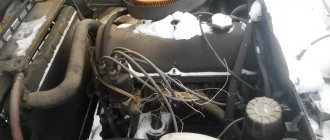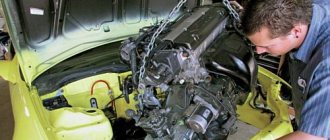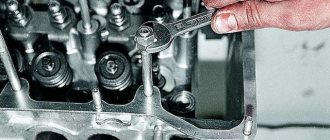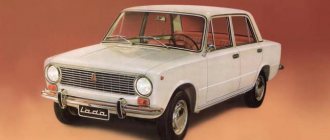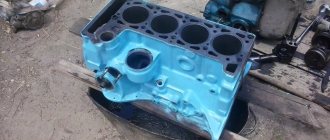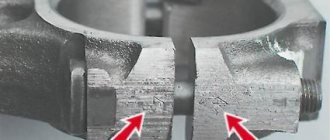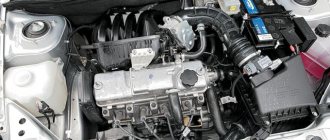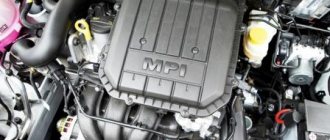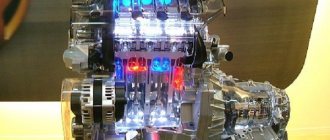Engine VAZ 2103-1000260. Characteristics of the VAZ 2103 engine.
The engine is four-stroke, carburetor, in-line, with an overhead camshaft. The engine cooling system is liquid, closed type, with forced circulation of liquid. The engine has a combined lubrication system: pressure and splash.
| Number of cylinders: | 4 |
| Cylinder displacement, l: | 1,45 |
| Compression ratio: | 8,5 |
| Rated engine power at a crankshaft speed of 5600 rpm: | 52.5 kW.-(71.4 hp) |
| Cylinder diameter, mm: | 76 |
| Piston stroke, mm: | 80 |
| Number of valves: | 8 |
| Minimum crankshaft speed, rpm: | 850-900 |
| Maximum torque at 3400 rpm, N*m: | 104 |
| Cylinder operating order: | 1-3-4-2 |
| Octane number of gasoline: | 91-93 |
| Fuel supply system: | carburetor |
| Spark plug: | A17DVR, FE65CPR, A17DV-10 |
| Weight, kg: | 120.7 |
Engine Features.
The VAZ 2103 engine can be used for installation on VAZ 2103, 2106, 2121, 21053, 2107 cars.
The VAZ 2103 and VAZ 2106 engines are structurally identical. The differences between them are due to different cylinder diameters. The cylinder diameter for 2103-1000260 is 76.00 mm.
The cylinder block is made with a center-to-center distance of 95 mm. Cylinder diameter - 76.00 mm. For the cylinder, the accepted dimensions between overhauls are 76.40 mm and 76.80 mm. The block height, the distance from the center of the crankshaft to the top surface of the block, is 215.9 mm (see “Cylinder block”)
The cylinder block is cast from special cast iron. Five classes are defined for the block cylinder diameter sizes. The classes are designated by Latin letters: A, B, C, D, E. Each subsequent class differs from the previous one by 0.01 mm. On the bottom surface of the block next to the hole of each cylinder its class is indicated.
The cylinder head 21011-1005011-10 of the engine is cast from aluminum alloy and is common to all cylinders. The head height is 112.5 mm, the combustion chamber measures 79x51 mm and has a volume of 33.2 cm3. Inside the chamber there is a milled step 2 mm high.
The VAZ 2103 engine is equipped with a camshaft 2101-1006010-20. A distinctive feature of the shaft is one untreated neck, shaped like a regular hexagon. It is located between the cams of the second cylinder.
For the timing drive, a double-row bush-roller chain 2103-1006040 with 116 links is used. A 944mm long V-belt is used to drive the generator and water pump. with a section (10x8).
The crankshaft mod.21213 is installed. It is interchangeable with crankshaft mod. 2103 but has improved characteristics. According to its parameters, it corresponds to the crankshaft 2103 and provides a piston stroke of 80 mm (crank radius - 40 mm).
The engine is equipped with model 2101 pistons and pins. The piston is made of aluminum alloy. The outer surface is covered with a layer of tin. There is no recess on the piston bottom. The piston must be selected in the same class as the cylinder class. There are three dimensional accuracy categories defined for the piston pin bore. Markings on the piston bottom allow you to determine whether it belongs to a certain class (letter) and pin hole category (number).
The piston rings installed on the engine are marked as a set - 2101-1000100-10, for a normal size of 76mm. The piston rings are made of cast iron. The top compression ring has a barrel-shaped chrome-plated outer surface. The lower compression ring is of the scraper type, subjected to hardening by phosphating. The oil scraper ring for the VAZ-2103 piston is not chrome plated. The oil scraper ring is equipped with an expander spring. On VAZ rings, the spring is wound with variable pitch and subjected to grinding along the ends and outer diameter.
Connecting rod mod. 2101. Length of connecting rod 136 mm. Each connecting rod has its own connecting rod cap, together with which it was processed. To eliminate errors during assembly, the connecting rod and connecting rod cap are marked with the number of the cylinder in which they are installed.
Carburetor 2107-1107010-20 is installed together with a distributor that has a vacuum ignition timing regulator.
The engine can be equipped with a classic or non-contact ignition system. With a contact ignition system, an ignition distributor 30.3706 with a B117A ignition coil is used. The contactless ignition system (BZS) uses a coil - 27.3705.
Generator G-221 (42 A). For starting, a starter 35.3708 with an end commutator is used.
Source
History of the VAZ 2103 1.5
In the early 70s, in the Soviet Union there was a need for a more powerful engine for domestic Zhiguli cars than the existing VAZ 2101 model. To obtain an engine with more power, it was decided to modify the already proven engine of the 01 model. Changing the height of the cylinders by almost 9 millimeters made it possible to increase the power and volume of the cylinders by 300 cubic centimeters.
In all other respects, this is the same VAZ 2101, which in turn is a modified copy of the FIAT 124, released in 1968. Model 01 engine is not an exact copy; Russian engineers changed the timing belt design. On an Italian car, the camshaft was located in the cylinder block, and the BC head was cast iron. It contained a jacket for coolant and holes intended for installing spark plugs.
On the 03 model, the BC head is made of aluminum alloy. It has supports in which the camshaft is installed; 8 valves are placed on it, 2 per cylinder.
This is how the legendary VAZ 2103 engine appeared in 1972. During production, this engine was supplemented several times. So, in 1974, the carburetor design was revised, two years later a fuel mixture quality screw was added, and in 1980, an “Ozone” carburetor began to be installed on the 03 engine. In 1977, the engine wiring underwent large-scale changes, the connectors and terminal design were changed. Even when the VAZ 2106 engine appeared, model 03, for several more years, was more popular and in greater demand than the six.
Engine characteristics 2103
Years of manufacture – (1972 – present time) Cylinder block material – cast iron Power system – carburetor/injector Type – in-line Number of cylinders – 4 Valves per cylinder – 2 Piston stroke – 80 mm Cylinder diameter – 76 mm Compression ratio – 8.5 Engine displacement 2103 – 1452 cm3 Engine power 2103 – 71 hp. /5600 rpm Torque - 104 Nm / 3400 rpm Fuel - AI93 Fuel consumption - city 9.4l. | track 6.9 l. | mixed 8.9 l/100 km Oil consumption - 700 g per 1000 km Weight of the VAZ 2103 engine - 121 kg Overall dimensions of the 2103 engine (LxWxH), mm - 565x541x665 Oil for the VAZ 2103 engine: 5W-30 5W-40 10W-40 15W-40 How much oil is in the 2103 engine: 3.75 l. When replacing, fill in about 3.5 liters.
Ignition system features
The VAZ 2103 engine uses a classic contact ignition system. Later they began to use contactless SZ. The contact ignition system consists of a 30.3706 distributor and a B117A ignition coil. With contactless SZ, an ignition coil 27.3705 is used.
The VAZ 2103 engine is equipped with a 42 A, G-221 alternating current generator. Inside the generator there is a diode bridge that converts alternating current into direct current.
Design of intake and exhaust manifolds of VAZ 2103
In the VAZ 2103 1.5 engine, the intake manifold, to improve idle performance, is equipped with a longer partition than the VAZ 2101 manifold. And the exhaust manifold remains unchanged. This allows you to perform tuning by installing a direct-flow muffler. This upgrade will significantly increase the vehicle's torque and power.
Malfunctions and repairs of the VAZ 2103 engine
Engine VAZ 2103 1.5 l. carburetor in-line 4-cylinder with an overhead camshaft, the timing belt of the 2103 engine has a chain drive. The VAZ 2103 engine block is tall, more on that below. The service life of the 2103 engine, with careful operation and timely maintenance, exceeds the 125 thousand km established by the factory and reaches 180-200 thousand km. The main differences between the 2103 engine and the 2101 engine are the increased block height by 8.8 mm from 207.1 mm to 215.9 mm to allow the installation of a crankshaft with an increased piston stroke, thanks to which the engine volume has increased to 1.5 liters. As noted in previous articles, Lada engines have a problem with camshaft wear. Due to the fact that the chain drive does not have a tensioner, the chain needs to be tightened, the engine also needs constant (every 10 thousand km) adjustment of the valve clearances, this will be indicated by a loud knocking sound in the VAZ 2103 engine when the engine is idling, audible from a standstill driver with the hood closed. Many people have a question, why adjust the valves, the answer is simple - power will decrease, fuel consumption will increase, the valve will burn out and many other pleasures of life. Adjustment of the VAZ 2103 engine valves must be done either by a master or with his own hands. Among other problems, Weber and Ozone carburetors constantly require CO adjustment and cleaning. It often happens that the VAZ 2103 engine gets hot, look for the problem in the pump, 99% this is it. Often when the engine in a 2103 misfires, there can be a lot of reasons, most often a burnt-out valve; in any case, you need to measure the compression and show the car to a mechanic. Many VAZ 2103 engine malfunctions repeat the problems of the 2101, due to their close relationship. For a more complete picture and so as not to miss anything, read about the 2101 engine here. Nevertheless, according to popular opinion, the 2103 engine is the most reliable and unpretentious among the classic line of engines, and given the prices for spare parts for the VAZ 2103 engine, you don’t have to wonder why the classics are still driving along our streets.
Reliability, weaknesses, maintainability
Reliability
Almost all car owners consider the VAZ-2103 unpretentious and reliable. When exchanging opinions on forums, owners express a common opinion.
So Andrey writes: “... before the three-ruble note came to me, the engine went through three repairs. Despite the age, the traction is enough for the eyes...” Ruslan notes the easy start: “...starting in cold weather. For example, yesterday I easily started the engine at -30, despite not bringing the battery home. High-torque motor. At least in the range of 3000-4000 rpm there is enough traction, and the dynamics, in principle, are not bad, especially for such an ancient car...”
Another noteworthy review. Yurievich (Donetsk) shares his experience: “... I also noticed one feature, and not only me. By changing oil from mineral water to semi-synthetic, engine life increases. 195 thousand have already passed since the capital, and it’s like a clock, compression is 11, doesn’t eat oil, doesn’t smoke...”
Reliability can be judged by the service life of the motor. With proper care, a VAZ-2103 can easily last more than 300 thousand km without major repairs.
In addition, the engine has a large margin of safety. Tuning enthusiasts manage to extract 200 hp from it. With.
But reasonable caution must be exercised in this matter. Excessive boosting of the motor significantly reduces its service life.
The simplicity of the internal combustion engine design also has a positive effect on the reliability of the unit.
The only conclusion is that the VAZ-2103 is a simple, unpretentious and reliable engine.
Weak spots
There are few weak points in the engine, but they exist. A characteristic feature is their repetition of the basic model.
Engine overheating occurs for two reasons. In most cases, the problem should be found in the water pump.
Less commonly, the culprit is a faulty thermostat. In any case, the faulty unit must be detected in a timely manner and replaced with a working one.
Rapid camshaft wear. Here the blame falls entirely on the manufacturer. The cause of the malfunction is the absence of a timing chain tensioner. Timely tensioning of the chain will eliminate the problem.
Unstable or floating engine speed. As a rule, the cause of the malfunction is a clogged carburetor.
Untimely maintenance, filling with gasoline of poor quality - these are the components of clogged nozzles or filters. Additionally, you need to check the adjustment of the carburetor control drive.
Extraneous noise during engine operation occurs when the valves are not adjusted. The source can also be a stretched timing chain. Fix the problem yourself or at a service center.
Engine tripping. The most likely reason for this phenomenon lies in a malfunction of the ignition system.
A crack in the cover of the breaker or its carrier, damaged insulation of high-voltage wires, or a faulty spark plug will certainly cause tripping.
Other minor faults are associated with oil leaks through the valve cover seals or oil pan. They are not fatal, but require immediate elimination.
As you can see, a significant part of the malfunctions is not a weak point of the engine, but occurs only when the engine is handled negligently by the car owner.
Tuning the VAZ 2103 engine
Boost engine 2103
There are a lot of methods for modifying the VAZ 2103 engine, like all classics, from boring to a compressor with turbines, but let’s start in order. How to boost the VAZ 2103 engine, the cheapest and simplest tuning of the VAZ 2103 engine was and remains boring the cylinders by 3 mm under a 79 mm piston from a VAZ 21011 or from a VAZ 2106, the output is 1.6 liters. Sharpening further, at 82 mm, will not work due to the too thin walls of the block. To further increase the volume, you need to increase the piston stroke to 84 mm. Increasing the volume in this way reduces the maximum operating speed; a low-end engine is not the best choice for racing, but still. To increase the power of the VAZ 2103 engine by piston stroke, install a VAZ 2130 crankshaft, and also use TRT pistons, the connecting rods are seated to 134 mm. The disadvantages of TPT pistons are their lower strength compared to standard ones, the thermal load on the ring and the likelihood of piston burnout.
Engine boring 2103
- larger diameter piston, standard stroke 1.6 liters. 79x80
75 hp Maximum torque
115 Nm at 3000 rpm With this configuration we get exactly the 2106 engine - larger diameter piston, standard stroke 1.7 liters. 79x84
80 hp Torque engine, non-racing configuration.
How to boost a VAZ 2103 engine by refining the cylinder head
The three-wheel engine uses the VAZ 2101 cylinder head, the main disadvantage of which is that it was developed for small-volume units. Accordingly, the flow sections of the channels do not correspond to the increased volume; this must be corrected by boring and polishing the channels. Polishing and boring the VAZ 2103 cylinder head channels and manifold will significantly reduce intake resistance, engine power increases by 10% throughout the entire range. How to polish and which shafts to select is described in the article “Tuning a VAZ 2101”, due to the identity of the engines, all this applies to the engine of the Lada troika. The modification of the 2103 engine does not end there; a correctly selected camshaft for the 2103, as well as a modified head, can produce more than 100 hp.
Camshaft on VAZ 2103
The rule for choosing a camshaft is simple: in a lower configuration, when the piston stroke is large and it is larger than the cylinder diameter, you need to take a lower shaft with a phase of up to 270, a larger valve lift. Such an engine will turn out to be quite high-torque, urban and will drive much better than the standard, while the high speeds will disappear. Which camshaft to choose for the lower ends, Estonets 1, Nivovsky 213 or something similar in parameters will do. For the top configuration, we accordingly select a wide-phase top shaft with a large valve lift. The standard head without modifications will accept the Mastermotor 48 camshaft, OKB Engine 480 and the like. More wide-phase ones will require additional work. The disadvantages of shafts with a wide phase are traction at the bottom; the angrier the shaft, the worse the ride at the bottom and the more uneven the idle, but by losing the bottom we gain high power at the top. It’s up to you to decide which direction to move and whether it’s worth moving at all; the basic and most popular principles of boosting the 2103 engine were presented to you as simply and easily as possible.
Features of the BC VAZ 2103
The BC of the engine 03 of the Zhiguli model is cast from especially durable cast iron. Inside there are main oil channels and jackets for coolant circulation. At the bottom of the crankshaft there are five supports for installing the crankshaft. The support covers are not interchangeable and should not be interchanged.
BC 03 differs from BC VAZ 2101 in its greater height distance. This is necessary to obtain an engine volume of 1.5 liters. The BC was manufactured taking into account a center-to-center distance of 95 millimeters. The cylinders have between-repair sizes. The diameter of the cylinder sizes has five classes. They are designated by Latin characters in alphabetical order from A to E. The difference between the classes in size is 0.01 mm. At the bottom of the BC, near the center of all cylinders, their class is indicated. Taking into account all possible cylinder repairs, the engine service life is about 800 thousand kilometers.
Technical characteristics of the engine 2103
In the third ICE 2103, the manufacturer AvtoVAZ returned the original cylinder diameter of 76 mm and increased the volume of the combustion chamber, so the technical characteristics of the engine are as follows:
| Manufacturer | VAZ |
| Engine brand | VAZ-2103 |
| Years of production | 1972 – 1983 |
| Volume | 1.5 l (1452 cm 3) |
| Power | 52.4 kW (71.4 hp) |
| Torque | 106 Nm (3400 rpm) |
| Weight | 120.7 kg |
| Compression ratio | 8,5 |
| Nutrition | carburetor DAAZ-2103 Solex (1972 - 1974), then Ozone 2107-1107010-20 |
| Motor type | in-line |
| Number of cylinders | 4 |
| Location of the first cylinder | near the timing chain |
| Number of valves on each cylinder | 2 |
| Cylinder head material | aluminum alloy |
| Allowable warpage | manifold gaskets (intake/exhaust) 0.08 mm cylinder head gasket 0.05 mm |
| Valve seat | width 2 – 2.4 mm, angle 45° |
| Camshaft | one upper cylinder head inside, phase width 232°, exhaust valve advance 42°, intake valve lag 40° |
| Camshaft oil seal | diameters – 40 mm, 56 mm, width 7 mm |
| Cylinder block material | cast iron |
| Cylinder diameter | class A – 76 – 76.01 mm class E – 76.04 – 76.05 mm |
| Pistons and rings | piston made of aluminum alloy with tin coating, cast iron rings, compression outside chrome plated (top) and beveled (bottom) |
| Piston diameter | class A – 75.94 – 75.95 mm class E – 75.98 – 75.99 mm |
| Gaps | piston/cylinder wall – 0.153 – 0.173 mm (standard) or 0.19 mm (maximum) piston rings – 110 mm relative to the cut plane |
| Upper compression ring | 1.535 – 1.555 mm |
| Lower compression ring | 3.957 – 3.977 mm |
| Oil scraper ring | 2.015 – 2.035 mm |
| Gap between piston groove and ring | 0.03 – 0.07 mm |
| Crankshaft | cast iron, casting |
| Number of main bearings | 5 |
| Gearbox neck diameter | 50.795 – 50.775 mm |
| Main journal gap | 0.1 – 0.5 mm |
| Connecting rod bearings | shaft journal diameter – 47.814 mm liner thickness – 1.448 mm liner width – 28.025 – 28.975 mm |
| Crankshaft oil seals | front – diameters 42 mm, 60 mm, width 7 mm rear – diameters 85 mm, 105 mm, width 10 mm |
| Piston stroke | 80 mm |
| Fuel | AI-92 |
| Environmental standards | Euro 2 |
| Fuel consumption | highway – 6.9 l/100 km combined cycle 8.9 l/100 km city – 9.4 l/100 km |
| Oil consumption | maximum 0.7 l/1000 km |
| Engine oil for 2103 | 5W-30 and 15W-40 |
| Engine oil volume | 3.75 l |
| Replacement frequency | every 55,000 km |
| Working temperature | 80° |
| Motor life | declared 125,000 km actual 200,000 km |
| Adjustment of valves | nuts and feeler gauge |
| Cooling system | forced, antifreeze-A40 |
| Coolant quantity | 9.75 l |
| water pump | polymer impeller, mounted on a block |
| Ignition | transistor contactless, coil B117A and distributor 30.3706 |
| Candles for 2103 | original – A17-DV |
| Gap between spark plug electrodes | 0.5 – 0.6 mm |
| Valve train chain | double-row roller, 116 links, length 49.54 – 49.58 cm |
| Cylinder operating order | 1-3-4-2 |
| Air filter | dry with replaceable cardboard cartridge and pre-cleaner, temperature adjustment according to the season |
| Oil filter | recommended Mann W914/2 |
| Flywheel | 129 teeth, 0.62 kg internal hole diameter – 25.67 mm outer diameter – 27.75 mm number of mounting holes – 6 pieces no offsets |
| Flywheel mounting bolts | M10x1.25 mm, length 23.5 mm, |
| Valve stem seals | Manufacturers Horse or Corteco |
| Compression | pressure in the cylinders from 10 bar, pressure difference in individual cylinders within 1 bar |
| Oil temperature | 80°С |
| Thermostat temperature | 80 – 84°С |
| Valve pressure inside the radiator cap | 0.7 – 1 bar |
| Content of harmful products in the exhaust | CH -1 |
| Tightening force of threaded connections | spark plug – 37.24 Nm bearing cover – 80.36 – 84.38 Nm (main) and 51 – 53.5 Nm (connecting rod) cylinder head - two stages 39.2 Nm, 112.7 Nm |
By default, the manufacturer recommends the use of fluids from this table and the parameter values contained in the motor description.
Design features
The engine diagram has the following nuances:
- camshaft from 2101 – one journal between the cams of the second cylinder is unprocessed (hexagon);
- cylinder head – inside the combustion chamber there is a 2 mm stage made by milling;
- drive - timing chain, pump and generator - 8 x 10 mm belt, 944 mm long;
- crankshaft from 2101 – 40 mm crank radius;
- The volume in the engine has been increased compared to the previous version 2101 - the block height is 8.8 mm larger, the piston stroke has increased.
For the domestic “classic” VAZ, there are general standards for what kind of oil to pour into the engine - 5W30/5W40 or 10W40/15W40. The cooling system here is combined (spraying and lubricant supply under pressure).
In this internal combustion engine, the intake manifold has a longer baffle to improve the stability of idle speeds, so the part is not suitable for earlier versions of engines. The exhaust manifold remained unchanged, allowing tuning through the use of a direct-flow muffler to increase the car's drive power.
What cars was it installed in?
The 2103 engine was created for the corresponding AvtoVAZ model, and later began to be installed on other cars of this manufacturer:
- VAZ 21023;
- VAZ 21043;
- VAZ 21053;
- VAZ 21061;
- VAZ 2107;
- VAZ 2121.
Due to technical features, the 2103 engine is always located longitudinally, so it is not used in front-wheel drive models.
Maintenance schedule
The official manual explains the design of the internal combustion engine and the timing of replacing consumables when servicing the engine:
| Maintenance object | Time or mileage (whichever comes first) |
| Timing belt | replacement after 100,000 km |
| Battery | 1 year/20000 |
| Valve clearance | 2 years/20000 |
| Crankcase ventilation | 2 years/20000 |
| Belts that drive attachments | 2 years/20000 |
| Fuel line and tank cap | 2 years/40000 |
| Motor oil | 1 year/10000 |
| Oil filter | 1 year/10000 |
| Air filter | 1 – 2 years/40000 |
| Fuel filter | 4 years/40000 |
| Heating/Cooling Fittings and Hoses | 2 years/40000 |
| Coolant | 2 years/40000 |
| Oxygen sensor | 100000 |
| Spark plug | 1 – 2 years/20000 |
| Exhaust manifold | 1 year |
Thanks to its simple design, oil changes and even major repairs can be done yourself. In Soviet times, car enthusiasts practiced engine modernization, the options for which are discussed below.
Recommendations for servicing VAZ 2103
The durability and quality of its operation depends on the correctness and timeliness of maintenance of the power unit.
- One of the most common and important car maintenance procedures is replacing the engine lubricant. Simultaneously with changing the oil, you need to replace the oil filter. The first oil change should be done after the break-in period, after 2000 km. Then every 10 thousand kilometers.
- Every 10 thousand kilometers it is necessary to check the tension of the timing chain and, if necessary, tighten it. Also, at this stage it is necessary to adjust the valve clearances.
- After 20 thousand km, the air and fuel filters must be replaced.
- After 30 thousand km, you need to replace the spark plugs and lubricate the ignition distributor; to do this, just drop 3 drops of motor lubricant into the oil can. During this period, before changing the engine oil, it is necessary to flush the engine lubrication system.
- After 40 thousand km, the engine starter is subject to diagnostics, bearings are lubricated, the commutator is cleaned, and brushes are replaced.
- After 60 thousand km, the generator is subject to diagnostics. It is necessary to lubricate the bearings, replace the brushes, and clean the commutator. At the same time, the coolant should be replaced.
Malfunctions: signs, causes and solutions
The following breakdowns are typical for the 2103 engine manufactured by VAZ:
| Breaking | Probable Cause | Elimination method |
| Engine 2103 does not start | solenoid valve failure | valve replacement |
| fuel pump failure | cleaning/replacing the fuel pump | |
| fuel filter contamination | installing a new filter | |
| gasoline does not flow into the carburetor | carburetor cleaning | |
| At XX speed floats or the engine stalls | idle speed adjustments are broken | adjusting the quality/quantity of XX modes with screws |
| carburetor is broken/clogged | carburetor repair and cleaning | |
| The gaps between the camshaft levers and the cams are misadjusted | gap adjustment | |
| Increased oil consumption | wear of seals | replacing gaskets |
| wear of the cylinder walls or piston rings | selection of repair kit rings | |
| Damage/deterioration of valve stem seals | installation of new caps |
Attention: When the timing chain breaks, the engine bends the valve, so the tension and general condition of the links should be periodically checked.
Operation of the treshka engine
In general, engine operation does not cause any particular problems. Timely completion of routine maintenance, oil changes, adjustment of the VAZ 2103 carburetor, and the use of high-quality motor fuel ensure a long period of engine operation. The operation of the engine also has its own specifics that must be taken into account.
One of the specific features of the 2103 engine is that the timing chain drive does not have a chain tensioner. This leads to the need for periodic inspection, and in some cases, restoration of normal operation is required. The regulatory frequency of such an audit is 10,000 km. With some experience, you can make this adjustment yourself. Here is a step-by-step action plan:
- completely unscrew the tensioner cap nut;
- using your finger to control the position of the tensioner rod, turn the crankshaft 1-1.5 turns in the direction of its rotation;
- as soon as the tensioner rod is sunk, the spring will automatically adjust the chain tension through the shoe;
- tighten the cap nut.
Another important regulatory procedure when operating a VAZ 2103 engine is adjusting the thermal valve clearances. The need to repair the valve arises when there is a distinct knocking sound in the engine at low speeds. Adjustment is carried out in the following order:
- Align the marks on the gear and camshaft housing.
- Use a wide feeler gauge of 0.15 mm to adjust the 8th and 6th valves.
- Rotate the crankshaft 180 degrees and adjust valves 4 and 7.
- Rotate the crankshaft another 180 degrees to align valves 1 and 3.
- Rotate the crankshaft 180 degrees again to adjust valves 5 and 2.
You can turn the crankshaft by rolling the car forward in fourth gear.
Tuning options
The most popular tuning types are:
- boring the cylinder diameter by 3 mm to increase the volume (for serial piston 2101 or 2106);
- increasing the piston stroke to 84 mm and using a crankshaft from 2130;
- replacing connecting rods with parts 134 mm long.
Thus, the 2103 engine is qualitatively superior to the two previous modifications of the internal combustion engine of the AvtoVAZ manufacturer. The owner of a Zhiguli did not need to think about which oil to use, since the instruction manuals 2101 - 2103 are as similar as possible.
Source
